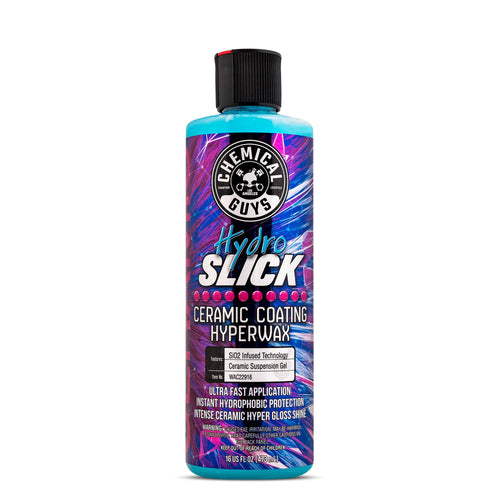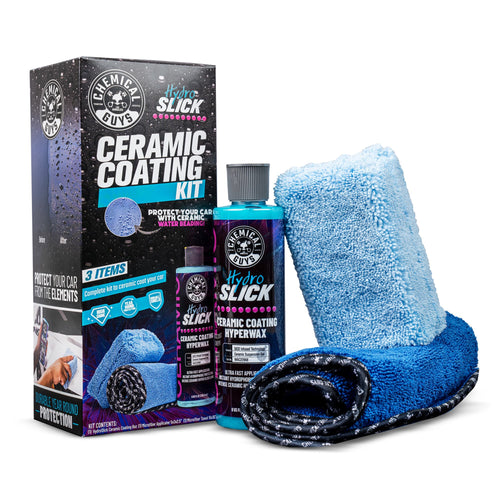Applying ceramic wax might seem like a job for seasoned detailers, but with Chemical Guys, it’s a hands-on, easy, and rewarding experience that leaves your ride with a flawless, high-gloss finish. Ready to make your car look unstoppable? Let’s break it down step by step.
Step 1: Get Your Detailing Arsenal Ready
Before you begin, ensure you have the necessary tools to achieve the best results. A great wax job isn’t just about the product – it’s about precision, technique, and using the proper materials to get that deep, liquid-like gloss.
- Microfiber Towels: Essential for buffing off wax without leaving streaks or fine scratches. Using a low-quality towel can dull your finish, so always use a plush, absorbent, lint-free option.
- Microfiber Applicator Pads: Designed for seamless, even application, these applicators help spread the wax smoothly, preventing uneven layers or patchy spots.
- HydroSlick Ceramic Wax: Combining the ease of wax application with the longevity of ceramic, this formula is packed with SiO₂ technology, bonding at a molecular level to deliver intense gloss, relentless hydrophobic properties, and long-lasting defense against contaminants.
Step 2: Prep Your Paint
Dirt and dust are the archenemies of a perfect wax job. If your car isn’t properly cleaned before applying ceramic wax, you’ll seal it in grime instead of protecting your paint. Start by giving your ride a meticulous wash with a high-quality car shampoo to strip away dirt, road film, and old wax. Dry your vehicle thoroughly with a soft microfiber drying towel to prevent water spots.
If your paint still feels gritty or rough, use our clay bar treatment to remove embedded contaminants, creating a slick, glass-like surface that allows the ceramic wax to bond correctly.
Pro Tip: Run your fingertips over the paint after washing. If it feels like sandpaper instead of satin, your surface needs extra decontamination before waxing. If that’s the case, then use our OG Clay Bar and Clay Luber to decontaminate the surfaces of your car. Apply a generous layer of lubricating spray and work the clay section by section until the paint feels glass-smooth.
Step 3: Spread The Shine
Ceramic wax works best when applied thinly and evenly – avoid overapplication. Too much product will make buffing harder and could lead to streaking or hazy patches.
Squeeze four to five pea-sized dots of HydroSlick Ceramic Wax onto a microfiber applicator pad. Using gentle, circular motions, work the wax onto the paint one section at a time—such as the hood, fender, or door—whatever feels right. Avoid applying wax in direct sunlight or on hot panels, as this can cause the product to dry too quickly, reducing its effectiveness.
Step 4: Let It Set
Once you’ve applied the wax, resist the urge to buff immediately. HydroSlick Ceramic Wax needs time to bond with the paint and activate its hydrophobic properties. Check the product instructions for the recommended cure time, but a good rule of thumb is to wait at least 10 to 15 minutes. If you’re working in a cooler environment, allow a little extra time for the wax to set correctly.
Pro Tip: If you’re detailing in a humid or cold climate, extend the cure time to ensure the wax fully adheres before buffing. Rushing this step reduces the longevity of the protection.
Step 5: Buff To Blinding Brilliance
Using a clean, dry microfiber towel, gently buff the wax off with light, sweeping motions. Don’t press too hard – let the towel do the work. As you buff, the deep, reflective gloss emerges, leaving behind a slick, water-repelling finish. If you see any streaks or haze, swap to a second clean microfiber towel for a final polish.
Pro Tip: For the most dazzling, crystal-clear finish, use a two-step buffing method: one towel to remove excess wax and a second to refine the shine to its peak potential.
The Ultimate Ceramic Wax Kit For Insane Shine And Protection
A next-level shine needs next-level protection, and the HydroSlick Ceramic Coating Kit delivers precisely that. This SiO₂-infused formula bonds to your paint, creating a slick, hydrophobic barrier that repels water, dirt, and UV rays for up to a year. Unlike traditional waxes that break down after a few weeks, this ceramic coating keeps your car looking freshly detailed for months.
Application is effortless, allowing you to spread a thin, even layer without heavy buffing or multiple coats. Once cured, it reveals a deep, glassy finish that intensifies color and locks in protection. For those new to ceramic protection, a bottle of HydroSlick Ceramic Coating provides an easy entry point, offering long-lasting defense, insane gloss, and water-repelling power in a simple wipe-on formula.
Read More:



